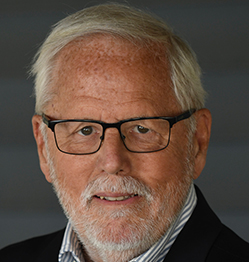Over his 38-year career at The Associated Press, Brian H. Horton was an important advocate for photojournalism in the world’s largest news organization and helped lead the industry’s transformations from black and white to color photography and from analog to digital photography and multimedia storytelling.
Photo credentials and passport stamps from hundreds of major news events and over three dozen countries are testament to a globetrotting and groundbreaking photojournalism career.
As a senior in high school, Horton’s picture of destruction from a gas main explosion made page one of The Indianapolis Star, where he worked as a copyboy. Thus began his lifelong journey in photojournalism.
He enrolled in Indiana University’s School of Journalism in 1968 and earned a coveted spot as a staff photographer for the Indiana Daily Student. By 1971, he also served as the AP’s primary photo stringer for news and sports assignments at the university.
Horton landed a summer stint on the AP’s Chicago photo desk. Later that summer, he jumped at a full-time job offer and never returned to the university to complete his degree.
After Chicago, Horton moved up through the ranks with bureau assignments in Philadelphia, Cincinnati and Columbus, covering a wide range of news and sports with his camera. Horton’s photo coverage of court-ordered busing in Louisville, Kentucky, in 1975 was nominated for the Pulitzer Prize.
In 1982, Horton was promoted to the AP’s New York headquarters, where he was responsible for planning and directing coverage, implementing new technologies and mentoring hundreds of photojournalists.
During his career, Horton oversaw the AP’s coverage of major news and sports events including a dozen Olympics, two dozen Super Bowls, Final Fours and the World Series. In 1991, Horton spent several weeks in Saudi Arabia and Kuwait covering the war and was among the journalists embedded with a convoy of coalition forces that entered Kuwait City to secure its freedom.
Horton was instrumental in the introduction of computer-based infographics and the transition to digital cameras and electronic picture handling. Later, he led another revolutionary shift, to multimedia storytelling for digital platforms, creating content while traveling widely to teach multimedia skills.
In 1990, Horton wrote “The Associated Press Photojournalism Stylebook,” followed in 2000 by the “Associated Press Guide to Photojournalism,” which is still widely used as a college textbook and guidebook for professional journalists.
Now retired, Horton spends his time photographing shore birds, sunsets and life near his home on the New Jersey coast. In 2021, he published a photo book, “beaches, bays and back roads,” dedicated to his late wife, Marilyn Dillon, a journalist herself. Proceeds were donated to the Robert Wood Johnson University Center for Multiple Sclerosis, which had overseen her care for many years.


